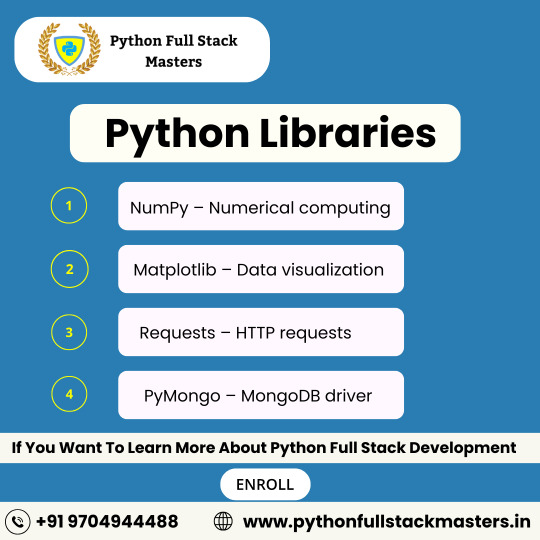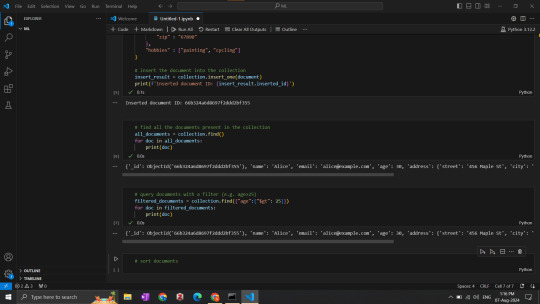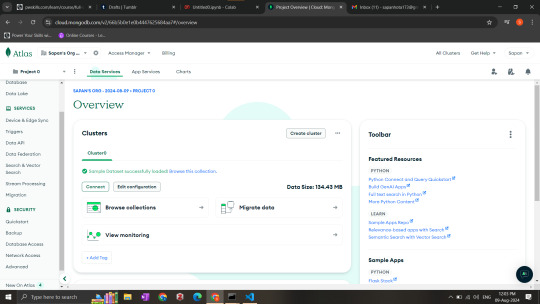#PyMongo
Explore tagged Tumblr posts
Text

📚 Top Python Libraries You Must Know!
Master the essential Python libraries every developer uses:
✅ NumPy – For powerful numerical computing ✅ Matplotlib – For beautiful data visualizations ✅ Requests – To handle HTTP requests easily ✅ PyMongo – Interact with MongoDB seamlessly
👉 Ready to become a Python Full Stack Developer?
📞 +91 9704944488 🌐 www.pythonfullstackmasters.in 📍 Location: Hyderabad, Telangana
#Python#PythonProgramming#LearnPython#PythonCourse#PythonForBeginners#PythonCommunity#PyMongo#MongoDBWithPython#FullStackDeveloper#TechSkills#TechEducation#CodingLife#ProgrammingJourney#OnlineLearning
0 notes
Text
PROJETO
Passo a Passo da Implementação da NeoSphere
1. Configuração do Ambiente de Desenvolvimento
Ferramentas Necessárias:
Python 3.10+ para backend Web2 (FastAPI, Redis).
Node.js 18+ para serviços Web3 e frontend.
Solidity para smart contracts.
Docker para conteinerização de serviços (Redis, MongoDB, RabbitMQ).
Truffle/Hardhat para desenvolvimento de smart contracts.
# Instalação de dependências básicas (Linux/Ubuntu) sudo apt-get update sudo apt-get install -y python3.10 nodejs npm docker.io
2. Implementação da API Web2 com FastAPI
Estrutura do Projeto:
/neosphere-api ├── app/ │ ├── __init__.py │ ├── main.py # Ponto de entrada da API │ ├── models.py # Modelos Pydantic │ └── database.py # Conexão com MongoDB └── requirements.txt
Código Expandido (app/main.py):
from fastapi import FastAPI, Depends, HTTPException from pymongo import MongoClient from pymongo.errors import DuplicateKeyError from app.models import PostCreate, PostResponse from app.database import get_db import uuid import datetime app = FastAPI(title="NeoSphere API", version="0.2.0") @app.post("/posts/", response_model=PostResponse, status_code=201) async def create_post(post: PostCreate, db=Depends(get_db)): post_id = str(uuid.uuid4()) post_data = { "post_id": post_id, "user_id": post.user_id, "content": post.content, "media_urls": post.media_urls or [], "related_nft_id": post.related_nft_id, "created_at": datetime.datetime.utcnow(), "likes": 0, "comments_count": 0 } try: db.posts.insert_one(post_data) except DuplicateKeyError: raise HTTPException(status_code=400, detail="Post ID já existe") return post_data @app.get("/posts/{post_id}", response_model=PostResponse) async def get_post(post_id: str, db=Depends(get_db)): post = db.posts.find_one({"post_id": post_id}) if not post: raise HTTPException(status_code=404, detail="Post não encontrado") return post
3. Sistema de Cache com Redis para NFTs
Implementação Avançada (services/nft_cache.py):
import redis from tenacity import retry, stop_after_attempt, wait_fixed from config import settings class NFTCache: def __init__(self): self.client = redis.Redis( host=settings.REDIS_HOST, port=settings.REDIS_PORT, decode_responses=True ) @retry(stop=stop_after_attempt(3), wait=wait_fixed(0.5)) async def get_metadata(self, contract_address: str, token_id: str) -> dict: cache_key = f"nft:{contract_address}:{token_id}" cached_data = self.client.get(cache_key) if cached_data: return json.loads(cached_data) # Lógica de busca na blockchain metadata = await BlockchainService.fetch_metadata(contract_address, token_id) if metadata: self.client.setex( cache_key, settings.NFT_CACHE_TTL, json.dumps(metadata) ) return metadata def invalidate_cache(self, contract_address: str, token_id: str): self.client.delete(f"nft:{contract_address}:{token_id}")
4. Smart Contract para NFTs com Royalties (Arquivo Completo)
Contrato Completo (contracts/NeoSphereNFT.sol):
// SPDX-License-Identifier: MIT pragma solidity ^0.8.20; import "@openzeppelin/contracts/token/ERC721/ERC721.sol"; import "@openzeppelin/contracts/access/Ownable.sol"; import "@openzeppelin/contracts/interfaces/IERC2981.sol"; contract NeoSphereNFT is ERC721, Ownable, IERC2981 { using Counters for Counters.Counter; Counters.Counter private _tokenIdCounter; struct RoyaltyInfo { address recipient; uint96 percentage; } mapping(uint256 => RoyaltyInfo) private _royalties; mapping(uint256 => string) private _tokenURIs; event NFTMinted( uint256 indexed tokenId, address indexed owner, string tokenURI, address creator ); constructor() ERC721("NeoSphereNFT", "NSPH") Ownable(msg.sender) {} function mint( address to, string memory uri, address royaltyRecipient, uint96 royaltyPercentage ) external onlyOwner returns (uint256) { require(royaltyPercentage <= 10000, "Royalties max 100%"); uint256 tokenId = _tokenIdCounter.current(); _tokenIdCounter.increment(); _safeMint(to, tokenId); _setTokenURI(tokenId, uri); _setRoyaltyInfo(tokenId, royaltyRecipient, royaltyPercentage); emit NFTMinted(tokenId, to, uri, msg.sender); return tokenId; } function royaltyInfo( uint256 tokenId, uint256 salePrice ) external view override returns (address, uint256) { RoyaltyInfo memory info = _royalties[tokenId]; return ( info.recipient, (salePrice * info.percentage) / 10000 ); } function _setTokenURI(uint256 tokenId, string memory uri) internal { _tokenURIs[tokenId] = uri; } function _setRoyaltyInfo( uint256 tokenId, address recipient, uint96 percentage ) internal { _royalties[tokenId] = RoyaltyInfo(recipient, percentage); } }
5. Sistema de Pagamentos com Gateway Unificado
Implementação Completa (payment/gateway.py):
from abc import ABC, abstractmethod from typing import Dict, Optional from pydantic import BaseModel class PaymentRequest(BaseModel): amount: float currency: str method: str user_metadata: Dict payment_metadata: Dict class PaymentProvider(ABC): @abstractmethod def process_payment(self, request: PaymentRequest) -> Dict: pass class StripeACHProvider(PaymentProvider): def process_payment(self, request: PaymentRequest) -> Dict: # Implementação real usando a SDK do Stripe return { "status": "success", "transaction_id": "stripe_tx_123", "fee": request.amount * 0.02 } class NeoPaymentGateway: def __init__(self): self.providers = { "ach": StripeACHProvider(), # Adicionar outros provedores } def process_payment(self, request: PaymentRequest) -> Dict: provider = self.providers.get(request.method.lower()) if not provider: raise ValueError("Método de pagamento não suportado") # Validação adicional if request.currency not in ["USD", "BRL"]: raise ValueError("Moeda não suportada") return provider.process_payment(request) # Exemplo de uso: # gateway = NeoPaymentGateway() # resultado = gateway.process_payment(PaymentRequest( # amount=100.00, # currency="USD", # method="ACH", # user_metadata={"country": "US"}, # payment_metadata={"account_number": "..."} # ))
6. Autenticação Web3 com SIWE
Implementação no Frontend (React):
import { useSigner } from 'wagmi' import { SiweMessage } from 'siwe' const AuthButton = () => { const { data: signer } = useSigner() const handleLogin = async () => { const message = new SiweMessage({ domain: window.location.host, address: await signer.getAddress(), statement: 'Bem-vindo à NeoSphere!', uri: window.location.origin, version: '1', chainId: 137 // Polygon Mainnet }) const signature = await signer.signMessage(message.prepareMessage()) // Verificação no backend const response = await fetch('/api/auth/login', { method: 'POST', headers: { 'Content-Type': 'application/json' }, body: JSON.stringify({ message, signature }) }) if (response.ok) { console.log('Autenticado com sucesso!') } } return ( <button onClick={handleLogin}> Conectar Wallet </button> ) }
7. Estratégia de Implantação
Infraestrutura com Terraform:
# infra/main.tf provider "aws" { region = "us-east-1" } module "neosphere_cluster" { source = "terraform-aws-modules/ecs/aws" cluster_name = "neosphere-prod" fargate_capacity_providers = ["FARGATE"] services = { api = { cpu = 512 memory = 1024 port = 8000 } payment = { cpu = 256 memory = 512 port = 3000 } } } resource "aws_elasticache_cluster" "redis" { cluster_id = "neosphere-redis" engine = "redis" node_type = "cache.t3.micro" num_cache_nodes = 1 parameter_group_name = "default.redis6.x" }
Considerações Finais
Testes Automatizados:
Implementar testes end-to-end com Cypress para fluxos de usuário
Testes de carga com k6 para validar escalabilidade
Testes de segurança com OWASP ZAP
Monitoramento:
Configurar Prometheus + Grafana para métricas em tempo real
Integrar Sentry para captura de erros no frontend
CI/CD:
Pipeline com GitHub Actions para deploy automático
Verificação de smart contracts com Slither
Documentação:
Swagger para API REST
Storybook para componentes UI
Archimate para documentação de arquitetura
Este esqueleto técnico fornece a base para uma implementação robusta da NeoSphere, combinando as melhores práticas de desenvolvimento Web2 com as inovações da Web3.
0 notes
Text
Flask and NoSQL: Build Modern Web Apps with MongoDB
1. Introduction Brief Explanation Flask, a lightweight Python web framework, and MongoDB, a leading NoSQL database, together provide a robust solution for building modern web applications. This tutorial explores their integration, emphasizing practical implementation and best practices. What You Will Learn Setup and configuration of Flask with MongoDB using PyMongo. CRUD operations…
0 notes
Text
蜘蛛池需要哪些代码?
蜘蛛池,通常指的是用于自动化抓取网页数据的工具或平台。在构建一个有效的蜘蛛池时,你需要考虑多种编程语言和框架,以确保能够高效、稳定地抓取数据。下面是一些关键的代码和技术要点,它们是构建蜘蛛池的基础。
1. 网络请求库
首先,你需要一个强大的网络请求库来发起HTTP请求。Python中的`requests`库是一个非常流行的选择,它简单易用且功能强大。对于更复杂的场景,如处理JavaScript渲染的页面,可以使用`Selenium`这样的库。
```python
import requests
response = requests.get('http://example.com')
print(response.text)
```
2. 数据解析库
抓取到的数据通常是HTML格式,因此需要一个解析库来提取有用的信息。`BeautifulSoup`是Python中常用的HTML解析库,它可以方便地从HTML文档中提取数据。
```python
from bs4 import BeautifulSoup
soup = BeautifulSoup(html_content, 'html.parser')
data = soup.find_all('div', {'class': 'content'})
```
3. 异步处理
为了提高效率,异步处理是必不可少的。Python的`asyncio`库提供了异步I/O的支持,可以显著提升爬虫的性能。
```python
import asyncio
import aiohttp
async def fetch(session, url):
async with session.get(url) as response:
return await response.text()
async def main():
async with aiohttp.ClientSession() as session:
html = await fetch(session, 'http://example.com')
print(html)
loop = asyncio.get_event_loop()
loop.run_until_complete(main())
```
4. 数据���储
抓取到的数据需要存储起来以便后续分析。常见的存储方式包括数据库(如MySQL、MongoDB)和文件系统。Python有丰富的库支持这些操作,如`pymysql`和`pymongo`。
```python
import pymysql
conn = pymysql.connect(host='localhost', user='root', password='password', db='spider_data')
cursor = conn.cursor()
cursor.execute("INSERT INTO data (url, content) VALUES (%s, %s)", ('http://example.com', html))
conn.commit()
```
5. 错误处理与重试机制
在实际应用中,网络请求可能会遇到各种问题,如超时、服务器错误等。因此,良好的错误处理和重试机制是必要的。
```python
from requests.exceptions import RequestException
def get_page(url):
try:
response = requests.get(url)
if response.status_code == 200:
return response.text
else:
return None
except RequestException:
return None
```
结语
构建一个高效的蜘蛛池需要综合运用多种技术和工具。以上介绍的只是一些基础的代码示例,实际应用中可能还需要考虑更多因素,如IP代理、反爬虫策略等。希望本文能为你的蜘蛛池开发提供一些启示。你认为在构建蜘蛛池时还应该注意哪些方面?欢迎在评论区分享你的观点!
加飞机@yuantou2048

SEO优化
谷歌留痕
0 notes
Text
Database Interactions Using Python

In today’s data-driven world, understanding how to interact with databases is a crucial skill for programmers and developers. Python, with its rich ecosystem of libraries, provides a seamless way to connect, query, and manage databases. At TCCI Computer Coaching Institute, we help students master this essential skill to build efficient and scalable applications.
This book discusses all the aspects of database interactions with Python, including core libraries, best practices, and real-world applications.
Why Learn Database Interaction in Python?
Databases form the heart of any application nowadays. It can hold information from user data to log files for transactions. In addition to these, Python presents very easy and efficient methods for interacting with various databases; either they are relational, such as MySQL, PostgreSQL, or SQLite, or NoSQL, like MongoDB.
Key to developing dynamic, data-driven applications is learning how to work with databases. At TCCI, we focus on hands-on training to assist you in connecting to a database, executing queries and retrieving data, performing CRUD operations, and using Python libraries to efficiently manage databases. Top Python Libraries for Database Interactions. To interact with databases using Python, you should get to know some of the top libraries used for the purpose. Let's see them below:
SQLite (sqlite3)
Best for: Small to medium database applications
Overview: sqlite3 is Python's built-in module which allows you to create and manage SQLite databases. Ideal for small to medium application or to understand how the database works.
Key Operations: Connecting, creating tables, inserting data, querying, and updating records.
MySQL Connector (mysql-connector-python)
Best for: Web applications, enterprise-grade systems
Overview: mysql-connector-python lets Python communicate with MySQL databases. This is an open-source library that makes the functions easily usable to handle MySQL database operations.
Key Operations: Connection, Query Execution, Transaction Handling, and Result Fetching.
SQLAlchemy
Best for: ORM (Object-Relational Mapping) in large applications
Overview: It is one of the most widely used libraries in Python to interact with relational databases. It supports multiple database engines like MySQL, PostgreSQL, SQLite, and others.
Key Operations: Querying databases with Python objects, database migrations, and schema management.
Psycopg2 (for PostgreSQL)
Best for: PostgreSQL-based applications
Overview: psycopg2 is the most used library to access PostgreSQL in Python. It is quite fast and reliable for working with complex queries and for database management.
Key Operations: Connect to PostgreSQL, execute SQL commands, and manage transactions.
MongoDB with PyMongo
Best for: NoSQL, document-based databases
Overview: PyMongo is the Python driver to access MongoDB, a NoSQL database. This is best suited for applications requiring flexible data structures or the need to scale horizontally.
Key Operations: Insert documents, update data, and perform aggregations.
Real-World Applications of Database Interactions Using Python
Web Development: The ability to interact with databases is a vital component in building web applications using frameworks such as Django and Flask. Databases will store user information, product information, and transaction records.
Data Analysis: The powerful libraries of Python enable you to pull data from databases for analysis, whether you want to generate reports, build machine learning models, or create visualizations.
Automation Scripts: Use Python for the automation of database backups, query execution, etc., to save time and prevent human error.
Becoming great and mastering Python database interactions means lots of experience for aspiring developers and data professionals. As part of TCCI Computer Coaching Institute, we aim to create a solid platform for learning Python database programming, enabling you to do everything else in the tech industry as well. Join us now.
Call now on +91 9825618292
Get information from https://tccicomputercoaching.wordpress.com/
#TCCI computer coaching institute#Best computer classes near me#Python programming training institute in Ahmedabad#Best computer training Bopal Ahmedabad#Best computer classes in Iskon crossroad Ahmedabad
0 notes
Text
Desperate to learn
Distractions today are like seagulls on the beach. You go prepared, but still get attacked. Today it is harder than ever to focus on things. Be it diminishing attention span, overstimulation or hyper-realistic expectations we all suffer.
So, I decided to alleviate my ADHD symptoms by finding extra engagement for my online lectures. I decided to log my classes like notes but on social media. Maybe it will be of use to others too. Here we go:
Date: 07-Aug-2024 | Subject: ML Projects | Class duration: 2h 12min
0 - 0:30:00 || Requirements-
Production level code
Cloud deployment
Deployment video
API
Logging
OPS Pipeline (AppRunner)
High Level Design and Low Level Design architecture documentation
Wireframe (draw.io)
Model accuracy, precision and recall score, error rate
Kanban board
0:30:00 - 0:56:28 || MongoDB-
ACID transactions
Documents vs keys (primary, functional)
Installation
0:56:28 - 01:15:00 || PyMongo
CRUD operations

01:15:00 - End || Atlas

Troubleshooting

More to come
0 notes
Text
Mastering Python: Your Guide to Excelling in a Full Stack Python Course
Embarking on the journey to excel in a Full Stack Python Course opens up a world of opportunities in the realm of web development. Python’s versatility and robustness make it an ideal language for both frontend and backend development tasks. In this blog, we’ll delve into the essential steps, resources, and strategies to help you succeed in a comprehensive Full Stack Python Course.
Understanding the Full Stack Python Developer Role:
Exploring the responsibilities and skill sets required for a Full Stack Python Developer.
Overview of frontend and backend development with Python.
Mastering Python Fundamentals:
Diving deep into Python programming language fundamentals.
Learning about data types, control structures, functions, and object-oriented programming (OOP) concepts.
Frontend Development with Python:
Introduction to frontend frameworks compatible with Python, such as Flask and Django.
Building responsive and dynamic user interfaces using HTML, CSS, and JavaScript along with Python.
Backend Development with Python:
Exploring the server-side capabilities of Python frameworks like Flask and Django.
Building RESTful APIs and handling database interactions with Python.
Database Management:
Understanding database systems commonly used in conjunction with Python, such as SQL and NoSQL databases.
Implementing database operations using Python libraries like SQLAlchemy and pymongo.
Version Control and Collaboration:
Introduction to version control systems like Git for tracking code changes.
Collaborating with other developers using platforms like GitHub.
Deployment and DevOps:
Deploying Python applications to various hosting platforms like Heroku, AWS, or DigitalOcean.
Understanding basic DevOps practices for continuous integration and deployment (CI/CD).
Continuous Learning and Resources:
Recommendations for further learning resources, including books, online courses, and tutorials.
Joining communities and forums to stay updated with the latest trends and best practices in Python development.
Conclusion:
Excelling in a Python Full Stack Course requires dedication, continuous learning, and hands-on practice. By following the outlined steps and utilizing the suggested resources, you can embark on a fulfilling journey towards mastering Python for both frontend and backend development tasks. Start your course today and unlock the endless possibilities of Full Stack Python development!
Interested in diving deeper into Full Stack Python Development? Explore our comprehensive Python Full Stack Course now available ! Take the first step towards mastering Python and building dynamic web applications.
0 notes
Text
TOP SKILLED ACADEMY
PYTHON PROGRAMMING LANGUAGE
In summary, Python‘s popularity can be attributed to its readability, versatility, strong community support, extensive libraries, and its adaptability to a wide range of applications. These factors have collectively contributed to Python becoming one of the most widely used programming languages in the world.
Python is a versatile programming language with a wide range of applications across various domains. Here are some common areas where Python is frequently used:

WEB DEVELOPMENT:Django: A high-level web framework for building web applications quickly and with less code. Flask: A lightweight web framework that is easy to use and extend, making it suitable for smaller web applications.
DATA SCIENCE & MACHINE LEARNING:NumPy and Pandas: Libraries for numerical computing and data manipulation. Scikit-learn: A machine learning library for classical machine learning algorithms. TensorFlow and PyTorch: Deep learning frameworks for building and training neural networks.
SCIENTIFIC COMPUTING:SciPy: A library for scientific and technical computing, built on top of NumPy. Matplotlib: A 2D plotting library for creating static, animated, and interactive visualizations in Python.
ARTIFICIAL INTELLIGENCE:Natural Language Toolkit (NLTK): A library for working with human language data. spacy: An open-source library for advanced natural language processing in Python.
AUTOMATION & SCRIPTING:Python is commonly used for writing scripts to automate repetitive tasks and system administration.
GAME DEVELOPMENT:Pygame: A set of Python modules designed for writing video games.
DESKTOP GUI APPLICATIONS:Tkinter: The standard GUI toolkit included with most Python installations. PyQt and wxPython: External libraries for creating cross-platform GUI applications.
NETWORKING:Python is used for network programming, including the development of network servers and clients.
CYBERSECURITY:Python is widely used in cybersecurity for tasks such as penetration testing, network scanning, and writing security tools.
DATABASES:Python has various libraries and frameworks for interacting with databases, such as SQLAlchemy for SQL databases and PyMongo for MongoDB.
MOBILE APP DEVELOPMENT:With frameworks like Kivy or BeeWare, Python can be used for developing mobile applications.
IOT (INTERNET OF THINGS):Python is used in IoT projects for its simplicity and ease of integration with various devices.
FINANCIAL & TRADING APPLICATIONS:Python is commonly used in the finance industry for tasks like data analysis, algorithmic trading, and risk management.
EDECATION:Python is widely used as a teaching language in schools and universities due to its readability and simplicity.
3D GRAPHICS & VISUALIZATION:Maya, Blender: Python can be used for scripting and automating tasks in 3D modeling and animation software.
These examples highlight the diverse range of applications for Python, showcasing its adaptability and widespread use in the software development landscape.
0 notes
Text
Essential Python Tools for Modern Data Science: A Comprehensive Overview

Python has established itself as a leading language in data science due to its simplicity and the extensive range of libraries and frameworks it offers. Here's a list of commonly used data science tools in Python:
Data Manipulation and Analysis:
pandas: A cornerstone library for data manipulation and analysis.
NumPy: Provides support for working with arrays and matrices, along with a large library of mathematical functions.
SciPy: Used for more advanced mathematical and statistical operations.
Data Visualization:
Matplotlib: A foundational plotting library.
Seaborn: Built on top of Matplotlib, it offers a higher level interface for creating visually pleasing statistical plots.
Plotly: Provides interactive graphing capabilities.
Bokeh: Designed for creating interactive visualizations for use in web browsers.
Machine Learning:
scikit-learn: A versatile library offering simple and efficient tools for data mining and data analysis.
Statsmodels: Used for estimating and testing statistical models.
TensorFlow and Keras: For deep learning and neural networks.
PyTorch: Another powerful library for deep learning.
Natural Language Processing:
NLTK (Natural Language Toolkit): Provides libraries for human language data processing.
spaCy: Industrial-strength natural language processing with pre-trained models for various languages.
Gensim: Used for topic modeling and similarity detection.
Big Data Processing:
PySpark: Python API for Apache Spark, which is a fast, in-memory data processing engine.
Web Scraping:
Beautiful Soup: Used for pulling data out of HTML and XML files.
Scrapy: An open-source and collaborative web crawling framework.
Requests: For making various types of HTTP requests.
Database Integration:
SQLAlchemy: A SQL toolkit and Object-Relational Mapping (ORM) library.
SQLite: A C-language library that offers a serverless, zero-configuration, transactional SQL database engine.
PyMongo: A Python driver for MongoDB.
Others:
Jupyter Notebook: An open-source web application that allows for the creation and sharing of documents containing live code, equations, visualizations, and narrative text.
Joblib: For saving and loading Python objects, useful when working with large datasets or models.
Scrapy: For web crawling and scraping.
The Python ecosystem for data science is vast, and the tools mentioned above are just the tip of the iceberg. Depending on the specific niche or requirement, data scientists might opt for more specialized tools. It's also worth noting that the Python data science community is active and continually innovating, leading to new tools and libraries emerging regularly.
0 notes
Text

Essential Python Tools Every Developer Needs
Today, we'll look at some of the most popular Python tools developers, coders & data scientists use worldwide. If you know how to use these Python tools correctly, they can be useful for various tasks.
Pandas: Used for Data Analysis Scipy: Algorithms to use with numpy PyMySQL: MYSQL connector HDFS: C/C++ wrapper for Hadoop connector Airflow: Data Engineering tool PyBrain: Algorithms for ML Matplotlib: Data visualization tool Python: Powerful shell Redis: Redis'access libraries Dask: Data Enginnering tool Jupyter: Research collabaration tool SQLAIchemy: Python SQL Toolkit Seaborn: Data Visuailzation tool Elasticsearch: Data Search Engine Numpy: Multidimensional arrays Pymongo: MongoDB driver Bookeh: Data Visualization tool Luigi: Data engineering tool Pattern: Natural language Keras: Hingh-lavel neural network API SymPy: Symbolic math
Visit our website for more information: https://www.marsdevs.com/python
0 notes
Text
Python FastAPI vs Flask

The world of web frameworks is constantly evolving, with new options emerging to meet the demands of modern web development. Two popular choices for building web applications with Python are Python FastAPI and Flask. In this article, we will compare these two frameworks in terms of performance, routing, database integration, documentation, community support, websocket support, deployment, scalability, and security. By the end, you should have a better understanding of which framework suits your needs. Before diving into the comparison, let's briefly introduce Python FastAPI and Flask. Both frameworks are used for building web applications and APIs, but they differ in their design philosophy and approach. What is Python FastAPI? Python FastAPI is a modern, high-performance web framework for building APIs with Python 3.7+ based on standard Python type hints. It is inspired by and fully compatible with FastAPI provides high performance, thanks to its asynchronous capabilities. What is Flask? Flask, on the other hand, is a lightweight web framework that aims to keep things simple and easy to understand. Flask is known for its simplicity and minimalistic approach, making it a popular choice among beginners. Comparison between Python FastAPI and Flask Performance and speed Python FastAPI shines in terms of performance and speed. It is built on top of Starlette, an asynchronous framework, which enables it to handle a large number of requests concurrently. FastAPI leverages the power of Python type hints and the asyncio library to provide high-performance APIs. Flask, while not as performant as FastAPI, is still a solid choice for small to medium-sized applications. It is built on top of Werkzeug and uses a traditional synchronous request handling model. Routing and request handling Both FastAPI and Flask provide flexible routing mechanisms. FastAPI uses a decorator-based approach similar to Flask, where you can define different routes for different endpoints. However, FastAPI introduces path parameters and query parameters directly in the route declaration, making it more intuitive and readable. Database integration When it comes to database integration, both frameworks support a wide range of databases and ORMs. FastAPI works seamlessly with SQLAlchemy, a popular Python SQL toolkit and Object-Relational Mapping (ORM) library, allowing you to interact with different database systems. Flask, on the other hand, is more flexible in terms of database integration. It provides various extensions, such as Flask-SQLAlchemy, Flask-MongoEngine, and Flask-PyMongo, that facilitate working with different database systems. Documentation and community support FastAPI excels in terms of documentation and community support. It provides detailed and well-organized documentation that covers almost every aspect of the framework. Thanks to its growing popularity, FastAPI has an active community that provides support and regularly contributes to its development. Flask, being one of the oldest frameworks in Python web development, has a vast and well-established community. It also offers comprehensive documentation and numerous resources, including tutorials, blog posts, and open-source projects. Websocket support Websockets are an important aspect of modern web applications, enabling real-time communication between the client and the server. FastAPI has built-in WebSocket support, making it easy to develop real-time applications on top of it. Flask, on the other hand, requires additional libraries like Flask-SocketIO or Flask-Sockets to add WebSocket functionality to your application. Deployment and scalability Both FastAPI and Flask can be easily deployed, with support for various deployment methods like Docker, Heroku, and AWS. FastAPI, thanks to its asynchronous capabilities, can handle a larger number of concurrent requests, making it more suitable for applications with high traffic or heavy load. Security Security is a critical aspect of any web application. FastAPI, by default, implements several security measures, such as rate limiting, authentication, and authorization, to protect your application. It also supports OAuth2 authentication out of the box. Flask, being a minimalist framework, provides the necessary building blocks for implementing security measures. However, additional libraries and extensions might be required to add certain security features. Conclusion In conclusion, Python FastAPI and Flask are both excellent choices for building web applications with Python. FastAPI offers superior performance, thanks to its asynchronous capabilities and type hints. It provides excellent documentation and has a growing community. Flask, on the other hand, is lightweight, easy to understand, and has a well-established community. When choosing between them, consider the specific needs of your project. If you require high performance, real-time capabilities, and extensive documentation, FastAPI is the way to go. If simplicity, minimalism, and an established community are more important, Flask is a solid choice. FAQ Can I use FastAPI with Python 2.7? No, FastAPI only supports Python 3.7 and above. It relies on features introduced in Python 3.7, such as type hints and asynchronous capabilities. Is Flask suitable for large-scale applications? While Flask can handle medium-sized applications well, it might not be the most suitable choice for large-scale applications due to its synchronous nature. Does FastAPI support other programming languages? No, FastAPI is a Python web framework and is primarily designed for Python developers. However, it can be used in conjunction with frontend frameworks and libraries written in other languages. Can Flask and FastAPI be used together in the same application? Technically, it is possible to use Flask and FastAPI together in the same application. However, it is generally recommended to choose one framework for consistency and simplicity. Are there any notable examples of applications built with FastAPI and Flask? Yes, several well-known applications have been built using FastAPI and Flask. Some examples include Netflix (Flask) and Microsoft (FastAPI). Read the full article
0 notes
Video
youtube
Python MongoDb Tutorial #3 - Inserting Documents/Data in MongoDb Atlas Using PyMongo in Python
1 note
·
View note
Photo

PyMongo Tutorial: Testing MongoDB Failover in Your Python App http://dev.thegeeknews.net/9b10971886 #python #pymongo #mongodb #app #developer
1 note
·
View note
Video
youtube
How to install pymongo? (Using Powershell in Windows)
0 notes
Text
蜘蛛池搭建需要哪些程序?
在互联网技术领域,蜘蛛池(Spider Pool)是一个相对专业且敏感的话题。它通常指的是用于自动化抓取网页信息的工具集合,这些工具可以模拟多个浏览器或用户行为,从而提高数据抓取的效率和成功率。然而,由于其可能涉及法律和道德问题,比如侵犯隐私、违反网站使用条款等,在使用时必须谨慎,并确保遵守相关法律法规。
如果从技术角度探讨如何搭建一个合法合规的蜘蛛池,以下是一些基本的程序和技术栈:
1. 爬虫框架:选择合适的爬虫框架是搭建蜘蛛池的第一步。常用的Python爬虫框架包括Scrapy、BeautifulSoup和PyQuery等。这些框架提供了强大的功能来解析HTML文档、处理请求和响应,以及管理爬虫��务。
2. 代理服务器:为了防止被目标网站封禁IP地址,通常会使用代理服务器。这可以通过购买商业代理服务或者自建代理池来实现。Python中可以使用`requests`库配合代理列表来实现。
3. 数据库系统:存储爬取到的数据至关重要。根据数据量和需求的不同,可以选择MySQL、MongoDB或其他数据库系统。Python中可以使用`pymysql`、`pymongo`等库与数据库进行交互。
4. 任务调度器:为了高效管理和调度爬虫任务,可以使用Celery、Airflow等任务调度工具。这些工具可以帮助你定时执行任务、监控任务状态并处理异常情况。
5. 分布式系统:对于大规模的爬虫项目,可能需要构建分布式系统以提高性能。Docker和Kubernetes是目前流行的容器化和集群管理工具,它们可以帮助你快速部署和管理多台服务器上的爬虫实例。
6. 日志记录和监控:维护良好的日志记录和监控系统对于调试和优化爬虫非常重要。可以使用ELK Stack(Elasticsearch、Logstash、Kibana)来收集、分析和可视化日志数据。
7. 合法性检查:最后但同样重要的是,确保你的爬虫活动符合所有适用的法律法规。这包括但不限于遵守robots.txt文件中的规定、尊重网站的使用条款以及保护个人隐私。
总之,搭建一个蜘蛛池不仅需要掌握多种技术和工具,还需要对法律和伦理有深刻的理解。希望这篇文章能为你提供一些有价值的参考。如果你有任何疑问或想要进一步讨论,请在评论区留言!
加飞机@yuantou2048

EPP Machine
EPS Machine
0 notes
Photo

PyMongo Tutorial: Testing MongoDB Failover in Your Python App http://dev.thegeeknews.net/9b10971886 #python #pymongo #mongodb #app #developer
0 notes